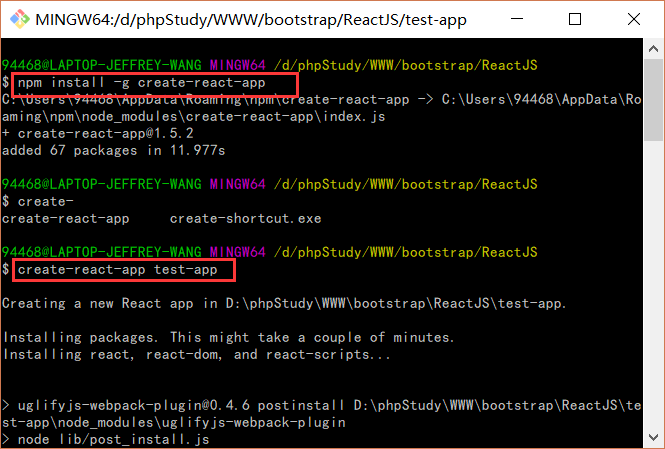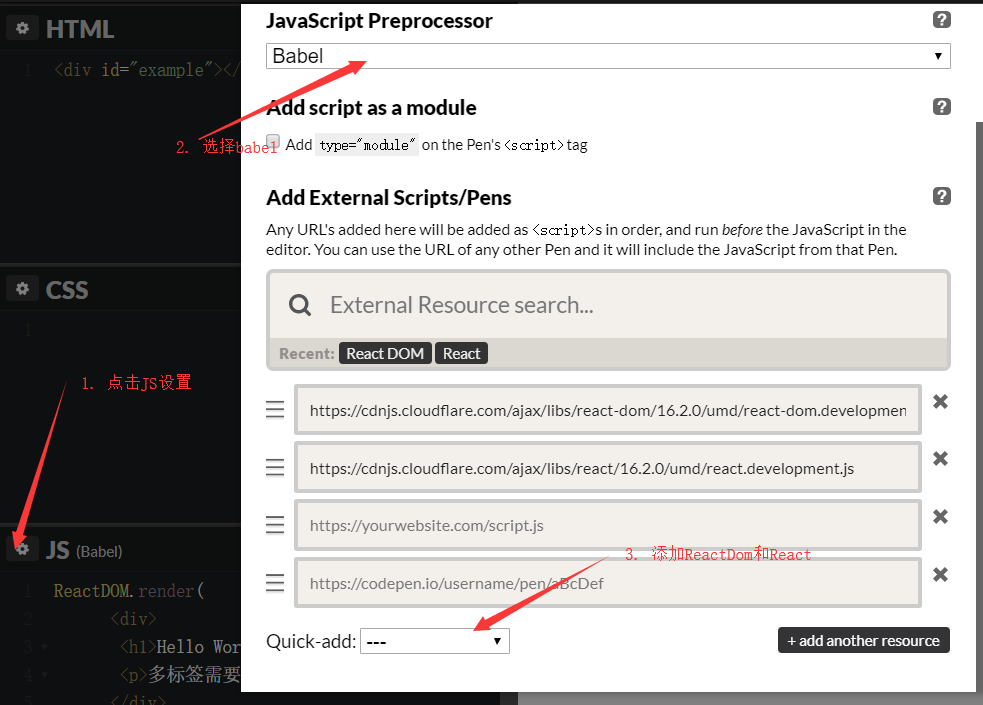
ReactJS学习(1) - 安装、JSX、组件、状态和生命周期
ReactJS学习笔记
安装React
安装条件准备
- 首先安装node,直接官网上下载安装即可。
- 安装完毕后,执行
npm install -g create-react-app,全局安装项目构建工具。
创建项目
create-react-app 项目名称,然后进入目录,cd 项目名称,最后npm start,完成项目的启动。浏览器中访问
localhost:3000即可访问项目。 访问效果:
访问效果: 
学习建议
开始的时候,可以在在线编辑器上实时调试,会比较方便,使用
create-react-app创建的文件全是用类构建,辅以nodeJS得以运行,效率较高。但是对于初学者来说,一层一层的类也容易绕晕,所以比较建议使用ReactDOM采用传统前端架构的形式来学习。 在线编辑器:https://codepen.io 注意:React需要在ReactDOM之前引入。 配置编辑器支持React 可以参考如下链接对sublime进行优化以适应react.js的JSX语法: https://segmentfault.com/a/1190000003698071
配置编辑器支持React 可以参考如下链接对sublime进行优化以适应react.js的JSX语法: https://segmentfault.com/a/1190000003698071
了解React JSX
优势
1 | |
学习React有啥用
大佬的博客介绍:https://www.cnblogs.com/clearyang/p/6898659.html 当然,吸引我的还有各种高大上的库,比如:阿里的后台模板,阿里的前端框架,阿里移动端框架,高大上的动效库 还有React Native,学会之后可以用React语法做出原生App了,还可以转换成Android和IOS,强大的不要不要的! React Native中文文档
简单渲染
ReactDOM能将渲染虚拟DOM至指定元素,仅需要调用render()函数即可。
1 | |
此段代码可以独立放到js文件中,然后引入即可(type=”text/babel”)。 在线演示:在CodePen中尝试
JavaScript表达式
{name}可以输出变量,并且支持内部表达式。
1 | |
注:JSX不支持if…else…,但是可以使用三目表达式来处理条件判断。 在线演示:在CodePen中尝试
设置样式和注释
JSX支持使用 camelCase 语法来设置内联样式 ,如:
1 | |
在线演示:https://codepen.io/wangerzi/pen/MGGPEb
展开数组
JSX自动展开数组元素
1 | |
在线演示:https://codepen.io/wangerzi/pen/OZZBxe
重新渲染
仅需要重新调用render()即可,并且React只更新需要更新的地方。
1 | |
在线演示:https://codepen.io/wangerzi/pen/LmmgOm
React组件
html标签和React组件渲染的区别
渲染html标签的时候,标签都是以小写字母开头,如:<div></div>等。 渲染自定义组件时,标签都是以大写字母开头,如:<MyComponent></MyComponent>等。 注:由于JSX也是JS,所以class,for等属性不宜直接书写,应写为className,htmlFor。
创建组件并渲染
创建一个函数MyComponent,接受一个参数props,props参数传递DOM的属性值。
1 | |
在线演示:https://codepen.io/wangerzi/pen/errPyv
复合组件(Composing Components)
新建组件的时候,可以自由组合其他组件,但是注意,复合的组件顶层也应该只有一个标签。
1 | |
注意:通过props给子组件传递参数时,不可加引号。 在线演示:https://codepen.io/wangerzi/pen/deegJj
拆分组件
一些嵌套比较深的组件,可以拆分为多个组件,独立出来以减少耦合。
1 | |
在线演示:https://codepen.io/wangerzi/pen/OZZBze
1 | |
在线演示:https://codepen.io/wangerzi/pen/LmmgQr 注意:无论是通过function直接创建组件,或者通过新增类来创建组件,处理方法都需要是纯函数,即:不得改变传递参数props的值。如果需要使用可变的变量,可以参考下一节的状态和生命周期。
状态和生命周期
之前构建自定义组件的时候,都是以函数式构建的,但是现在需要以类来构建,以支持状态。
组件状态
注意:新老版本创建类的代码不一样,请注意区别。
1 | |
在线演示:https://codepen.io/wangerzi/pen/MGGzwO 老版本表现方法:https://www.cnblogs.com/javascript-center/p/5533131.html 注意:内部this.state = {data: new Date()};即为状态,完全由组件自己管理,可以随意组件的意愿改变。 constructor(){}为构造函数,可用于初始化组件状态。
生命周期
在一个具有许多组件的应用程序中,在组件被销毁时释放所占用的资源是非常重要的。 组件渲染时,有一些特殊的回调,我们称为钩子函数,如:有一个componmentDidMount钩子函数,会在首次加载到DOM的时候会执行函数内容,再比如componmentWillUnmount钩子函数,会在卸载DOM的时候执行函数内容。 注意:this.setState(obj);会触发DOM的重新渲染,直接this.state.xxx = xxx;是不触发渲染的。
1 | |
引用官网文档:
来快速回顾一下该过程,以及调用方法的顺序:
- 当
<Clock />被传入ReactDOM.render()时, React 会调用Clock组件的构造函数。 因为Clock要显示的是当前时间,所以它将使用包含当前时间的对象来初始化this.state。我们稍后会更新此状态。- 然后 React 调用了
Clock组件的render()方法。 React 从该方法返回内容中得到要显示在屏幕上的内容。然后,React 然后更新 DOM 以匹配Clock的渲染输出。- 当
Clock输出被插入到 DOM 中时,React 调用componentDidMount()生命周期钩子。在该方法中,Clock组件请求浏览器设置一个定时器来调用匿名方法更新this.state.date。- 浏览器会每隔一秒调用一次 匿名方法。在该方法中,
Clock组件通过setState()方法并传递一个包含当前时间的对象来安排一个 UI 的更新。通过setState(), React 得知了组件state(状态)的变化, 随即再次调用render()方法,获取了当前应该显示的内容。 这次,render()方法中的this.state.date的值已经发生了改变, 从而,其输出的内容也随之改变。React 于是据此对 DOM 进行更新。- 如果通过其他操作将
Clock组件从 DOM 中移除了, React 会调用componentWillUnmount()生命周期钩子, 所以计时器也会被停止。
使用状态(state)的三个要点
不能直接在钩子函数里边修改
this.state,因为这并不会令DOM更新,只有在constructor()内直接修改this.state才是有效的,应该使用this.setState({name: value})1
2
3
4// 错误的示范
this.state.date = new Date();
// 正确的示范
this.setState({date: new Date()});state的更新可能是异步的,因为出于性能优化的考虑,可能会将多个setState合并为一个进行更新。所以说,不能直接依赖
this.props或者this.state1
2
3
4
5
6// 错误的示范
this.setState({count : this.state.count + 1)。
// 正确的示范
this.setState(function(prevState, props){
return {count: prevState.count + 1};
});state的更新会被合并,每次更新不同的项目并不会互相影响,比如:
1
2
3
4
5
6
7
8
9
10
11
12
13
14
15
16
17
18
19
20
21
22
23
24
25class CommentBox extends React.Component{
constructor(props){
super(props);
this.state = {
users: [],
comments: [],
}
}
componentDidMount(){
this.setState({users: ['user1', 'user2']});
this.setState({comments: ['1111', '233333']});
}
render(){
return <div>
users:
{this.state.users}
comments:
{this.state.comments}
</div>;
}
}
ReactDOM.render(
<CommentBox />,
document.getElementById('example')
);state可以通过属性的形式向下传递,比如子组件
<Clock name={this.state.name}>,子组件并不在意上层组件传递的数据是 state、prop或者手动写入,也不论上层组件是函数式抑或类,都使用this.props.xxx来进行参数接受。1
2
3
4
5
6
7
8
9
10
11
12
13
14
15
16
17
18
19
20
21
22
23
24
25function MyName(props){
return <h2>Hello, My name is {props.data}</h2>;
}
function MyAge(props){
return <h2>My Age is {props.data}</h2>;
}
class MyInfo extends React.Component{
constructor(props){
super(props);
this.state = {
name: props.name 'Wang',
age: props.age 21,
}
}
render(){
return <div>
<MyName data={this.state.name} />
<MyAge data={this.state.age} />
</div>;
}
}
ReactDOM.render(
<MyInfo name="Wang" />,
document.getElementById('example')
);